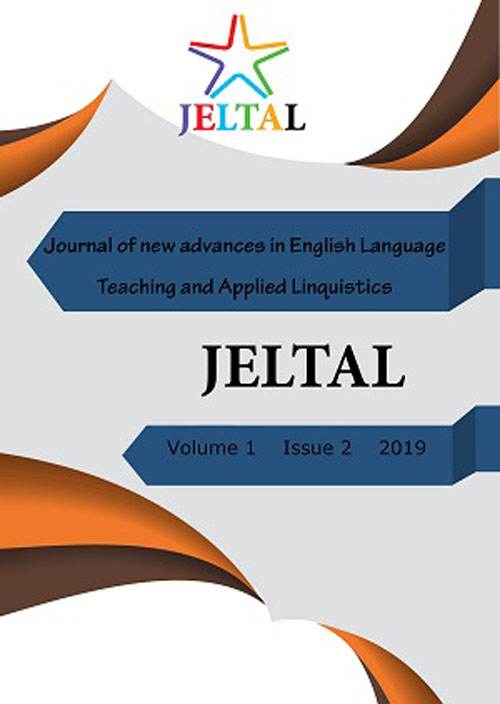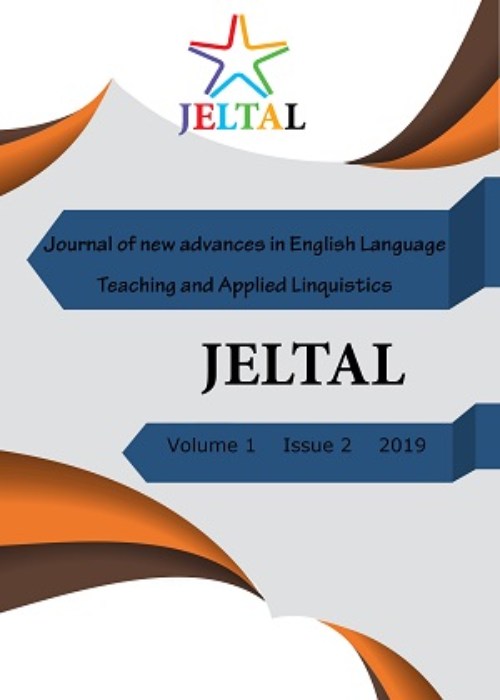فهرست مطالب

Journal of new advances in English Language Teaching and Applied Linguistics
Volume:3 Issue: 1, Winter and Spring 2021
- تاریخ انتشار: 1400/04/27
- تعداد عناوین: 6
-
Pages 462-477Few studies to date have investigated how native English scholars and non-native English scholars establish their authorial identity through first person pronouns. To this end, utilizing Işık-Taş’s discourse functions of first person pronouns (2018) as the analysis framework, it aims to examine how the authorial identity is represented by first person pronouns (I/me/my/we/us/our) in 40 English research articles of Applied Linguistics respectively written by native speaker scholars and non-native speaker scholars. Two sub-corpora were analyzed: native English speaker corpora and non-native English speaker corpora. The singular first person was found to be the preferred choice by both scholars. However, the analyses revealed differences in the distribution and discourse functions of first person pronouns. The first person occurred more frequently in native English speaker corpora than does non-native English speaker corpora. Based on Işık-Taş (2018) framework, low-risk functions (e.g., representing a community) and medium-risk functions (e.g., stating a goal) contrasted starkly between the two corpora. The variation in both corpora suggests that the use of first person pronouns in English research articles is not only associated with the cultural context but also by the author’s proficiency and competitiveness to publish paper internationally.Keywords: authorial identity, first person pronoun, Research Article, discourse function
-
Pages 478-493Investigating teachers’ characteristics concerning both effective teachers and subject matter’s specific characteristics has been of significance in teacher education. Having collected both statistical and textual data, the current study sought to explore Iranian learners’ attitudes on the distinctive characteristics of English language teachers. The study deliberately focused on private language institutions learners in so far as it was thought that they would are in much contact with English teachers both at schools and language institutions. To this end, 15 language learners took part in the research. Questionnaires, in-depth interviews, and focus group interviews were utilized as the main tools of data collection. Descriptive statistics were used to analyze and interpret quantitative data, and the collected qualitative data were analyzed through content analysis. Six themes were generated out of the qualitative data: the nature of the subject, the content of teaching, methodology, teacher-student relationship, economy, and target population. The study has a number of implications for language teachers and teacher education.Keywords: English language teachers, Learners’ attitudes, Mixed-method study, Teaching Quality
-
Pages 494-505This study was an attempt to investigate the impact of personality types on language learning by a group of Iranian teachers. Therefore, 30 male and female teachers as English learners teaching in different fields in Quchan a city in north east in Iran were selected as research participants through convenience sampling. The instruments used to gather the data were the Myers and Briggs Test Inventory (MBTI) for identifying their personality types, and another inventory was the teacher's final scores of their course as a proficiency test for identifying their level of success in language learning. To analyze the data, SPSS software was used. The results of the study showed that there was a significant and meaningful relationship between some personality types and foreign language learning by Iranian teachers. Also some results show that sometimes personality doesn't affect learning English so there must be other reasons that affect teacher's learning language.Keywords: Personality Types, language learning, Myers, Briggs Test, Teachers, Iran
-
Pages 506-517Vocabulary is one of the language components with which many learners have problems. The present study compared the effect of note taking and semantic mapping on vocabulary learning and retention of intermediate Iranian EFL learners. A total number of 98 took a proficiency test and based on its scores, 74 more homogeneous learners were selected as the participant of the study. The participants were then non-randomly assigned to two experimental groups and a control group. Note taking and semantic mapping were used each in one of the experimental groups while the control group used none of the strategies. A pre-test, a post-test, and a delayed posttest were employed to assess the efficiency of the strategies. The collected data were analyzed using descriptive statistics and one-way ANOVAs. The results showed that note taking and semantic mapping strategies had no significantly different effects on the participants' vocabulary learning and vocabulary retention. However, note taking showed to be significantly more effective than no strategy on the posttest although this difference was not seen on the delayed posttest. The findings of the study have implication for both language teachers and learners which are discussed in the paper.Keywords: note taking, Semantic Mapping, Vocabulary, vocabulary learning, vocabulary retention
-
Pages 518-533The present study investigated the effect of using an English vocabulary learning application called “Drops” as a tool in helping English as foreign language (EFL) young learners in pre-intermediate level learn English vocabulary. This app was designed to be installed into smartphones with Android and IOS system. To examine the program’s effectiveness, two groups of students (40 learners in each group) in two kinds of genders were set up as an experimental group (those with “Drops”) and a control group (those without “Drops”). Knowledge of the vocabulary after homogenizing learners tested before and after using this app by pre-test and post-test PET multiple-choice test, to assess the impact of the using this app on vocabulary learning on young EFL learners in Iran. The results of the study showed that the learners who use the application significantly outperformed those in the control group that learn vocabularies by traditional methods. At the conclusion of the study, the researcher realizes that 1) using technology such as digital games should be highly emphasized where learning vocabulary is the focus of the study, 2) teaching vocabulary traditionally in the control group, though was less significant than the experimental group in this study, should be also utilized as the second priority in teaching vocabulary in class, 3) the findings revealed no difference in learning English vocabulary based on gender.Keywords: EFL, Gaming in Language Learning, vocabulary learning
-
Pages 534-562The process of translation from one language into another is a very sensitive job as the translator needs to give importance to the cultural aspects of translation. Newmark (1988) points out five areas from which cultural items may come and twenty strategies for the translation of Culture-Specific-Items (CSIs).This research focused on translating CSIs in eight entrances of Saadi’s Gulistan and its two translations by a native and a non-native Persian translator. Through a quantitative and qualitative investigation, the research attempted to consider the application of Newmark's cultural category to distinguish CSIs. The data extracted from the corpus were rated by two raters to calculate inter-rater reliability.Consequently, two hundred twenty two CSIs were detected in the corpus and the results of data gathering and analysis indicated that "synonymy" was the most frequently employed strategy for translating CSIs by the two translators. This paper presents new insights in the field of CSI translation.Keywords: Culture-Specific Items, culture, literary translation, translation strategies


